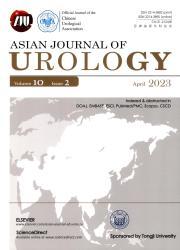增强术后功能恢复:MAIA™远程康复平台对机器人辅助根治性前列腺切除术患者的影响
IF 2.4
3区 医学
Q2 UROLOGY & NEPHROLOGY
引用次数: 0
摘要
目的评价MAIA™远程医疗平台用于机器人辅助根治性前列腺切除术(RARP)患者术后远程监护和远程康复的疗效和用户满意度。方法将接受RARP治疗的患者(2022年4月至2023年1月)分为标准康复方案的A组和干预后30天使用MAIA™平台的B组。收集围手术期、病理和功能变量(通过有效问卷评估的失禁和效力率),并监测远程康复方案的依从性。远程康复系统包括一个供医疗提供者使用的在线平台和一个患者应用程序,便于数据采集、管理、治疗计划和监测。采用视觉模拟量表评分和验证的远程医疗满意度问卷对患者和提供者满意度进行评估。结果共纳入227例患者。围手术期及病理指标均无差异。B组药物效价回收率高于A组(p=0.031);B组1个月和3个月的效价恢复率分别为45%和57%,A组分别为34%和48%。在多变量分析中,MAIA™的使用和神经保留(NS)是1个月(MAIA™使用:奇比[OR] 2.03, 95%可信区间[CI] 1.13-3.63, p=0.018; NS: OR 2.08, 95% CI 1.06-4.12, p=0.034)和3个月(MAIA™使用:OR 1.89, 95% CI 1.07-3.34, p=0.028; NS: OR 1.90, 95% CI 1.02-3.54, p=0.044)勃起功能的独立预测因子。依从性监测显示,B组4.6%的患者报告因骨盆疼痛发作而出现运动问题,10%的患者因肌痛而未服用口服磷酸二酯酶5-抑制剂。所有这些病人都在看完电视后重新开始了康复计划,以解决导致问题的原因,从而允许重新开始康复计划。患者报告了对MAIA™平台使用的高满意度(平均视觉模拟量表得分:88.7)。结论MAIA™远程医疗平台对RARP术后早期效价恢复具有优化作用。患者和提供者的满意度水平很高,强调了平台的用户友好性。本文章由计算机程序翻译,如有差异,请以英文原文为准。
Enhancing postoperative functional recovery: Impact of the MAIA™ telerehabilitation platform in robot-assisted radical prostatectomy patients
Objective
To evaluate the efficacy and user satisfaction of the MAIA™ telemedicine platform for postoperative telemonitoring and telerehabilitation in patients undergoing robot-assisted radical prostatectomy (RARP).
Methods
Patients undergoing RARP (from April 2022 to January 2023) were divided into Group A, following the standard rehabilitation protocol, and Group B using the MAIA™ platform for the first 30-day post-intervention period. Perioperative, pathological, and functional variables (continence and potency rates, assessed via validated questionnaires) were collected and telerehabilitation protocol's adherence was monitored. The telerehabilitation system included an online platform for medical providers and a patient application, facilitating data acquisition, management, treatment planning, and monitoring. Patient and provider satisfaction were evaluated using the visual analogue scale score and validated telemedicine satisfaction questionnaire.
Results
Totally, 227 patients were enrolled. No differences in perioperative or pathological variables were found. Group B had higher potency recovery rates than Group A (p=0.031); the potency recovery rates at 1 month and 3 months for Group B were 45% and 57%, respectively, and in Group A were 34% and 48%, respectively. At the multivariate analysis, MAIA™ use and the nerve-sparing (NS) were independent predictors of erectile function at both 1 month (MAIA™ use: odd ratio [OR] 2.03, 95% confidence interval [CI] 1.13–3.63, p=0.018; NS: OR 2.08, 95% CI 1.06–4.12, p=0.034) and 3 months (MAIA™ use: OR 1.89, 95% CI 1.07–3.34, p=0.028; NS: OR 1.90; 95% CI 1.02–3.54, p=0.044). Adherence monitoring revealed 4.6% of patients in Group B reported exercise issues due to pelvic pain onset and 10% did not take oral phosphodiesterase 5-inhibitors due to myalgia. All those patients restarted the rehabilitation program after televisit to address the causing problem, allowing restarting of a rehabilitation program. Patients reported high satisfaction with the MAIA™ platform use (mean visual analogue scale score: 88.7).
Conclusion
The MAIA™ telemedicine platform seems to have a role in optimizing early potency recovery after RARP. Patient and provider satisfaction levels were high, emphasizing the user-friendliness of the platform.
求助全文
通过发布文献求助,成功后即可免费获取论文全文。
去求助
来源期刊

Asian Journal of Urology
UROLOGY & NEPHROLOGY-
CiteScore
4.00
自引率
3.80%
发文量
100
审稿时长
4 weeks
期刊介绍:
Asian Journal of Urology (AJUR), launched in October 2014, is an international peer-reviewed Open Access journal jointly founded by Shanghai Association for Science and Technology (SAST) and Second Military Medical University (SMMU). AJUR aims to build a communication platform for international researchers to effectively share scholarly achievements. It focuses on all specialties of urology both scientifically and clinically, with article types widely covering editorials, opinions, perspectives, reviews and mini-reviews, original articles, cases reports, rapid communications, and letters, etc. Fields of particular interest to the journal including, but not limited to: • Surgical oncology • Endourology • Calculi • Female urology • Erectile dysfunction • Infertility • Pediatric urology • Renal transplantation • Reconstructive surgery • Radiology • Pathology • Neurourology.
 求助内容:
求助内容: 应助结果提醒方式:
应助结果提醒方式:


